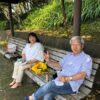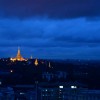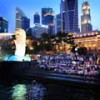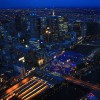City Night Walk in Kyoto
2019.09.26 Mutsuro Honma+Yumi Komatsu + Taiichiro Ishida+ Amane Kotani
Our first investigation in Kansai in 4 years occurred in Kyoto. We investigated whether Kyoto, where there are many tourists all year round, is retaining its ‘Kyoto-ness’.
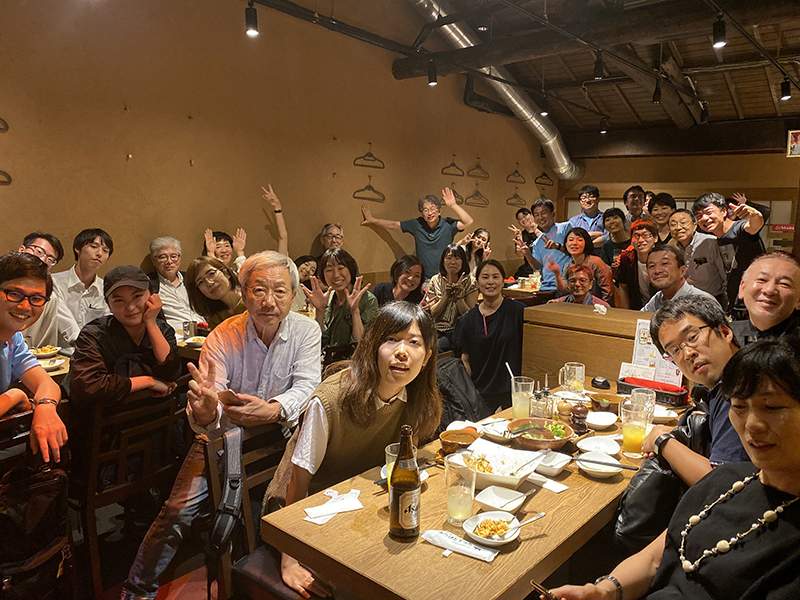
The scene at our gathering after the stroll. Many first time participants in the strolls also participated here. Endless conversation filled the space.
Main Objectives of Stroll about Town Kyoto
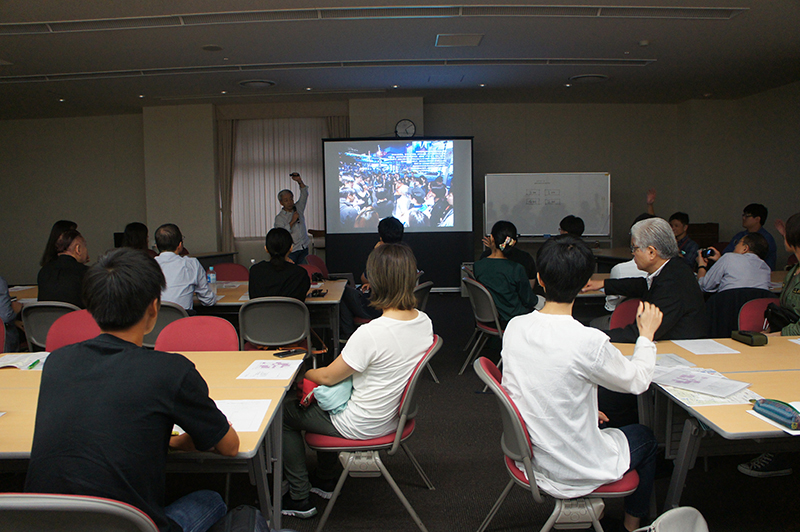 Orientation
Orientation
It has been a year since I started living in Kyoto, but I still encounter charms of the place that I have not before. Its attractions are unique and various, and discovering them seems as if I’m drawing out even more of the beauty of the more I explore.
Our investigation of Kyoto has been long awaited. ‘Kyoto is a city that is dear to all of us’ as Leader Mende-san’s introduced at the start of our event. I was very interested in how everyone would feel about Kyoto and excited to see what new attractions in Kyoto everyone would find.
We explored Kyoto in 4 groups, each responsible for a Tourist attraction. Let us dive right into what we found!
Group 1: Kiyamachi→Ponto-chou→Kamogawa
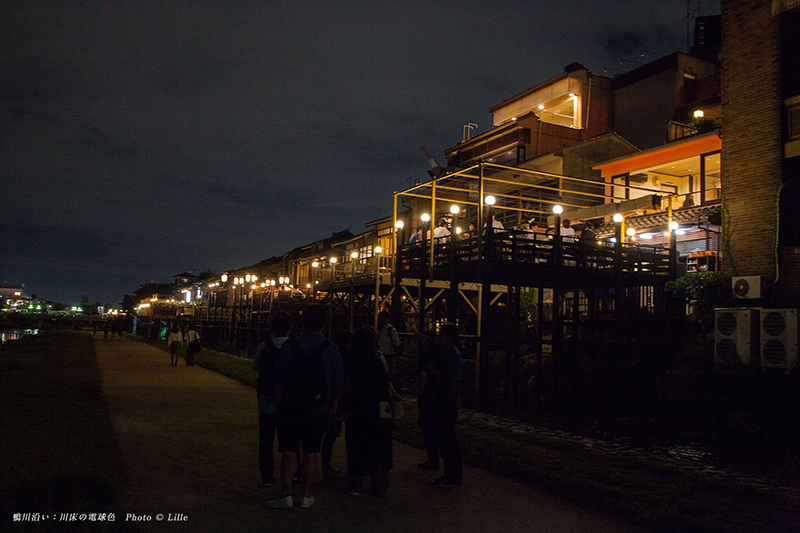 The lights on the floor that ‘Lights the dark’ continues all the way to Minamiza
The lights on the floor that ‘Lights the dark’ continues all the way to Minamiza
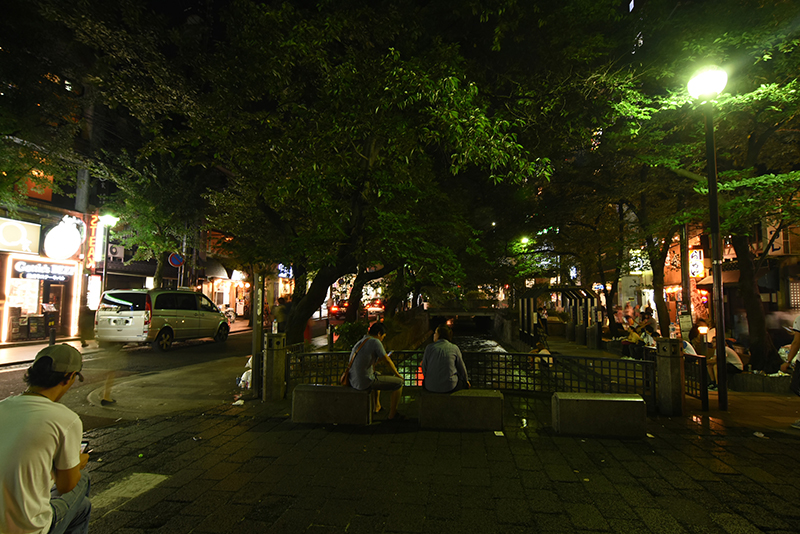 Kiyamachi Street that runs along Takasu River that is supposed to be expressive
Kiyamachi Street that runs along Takasu River that is supposed to be expressive
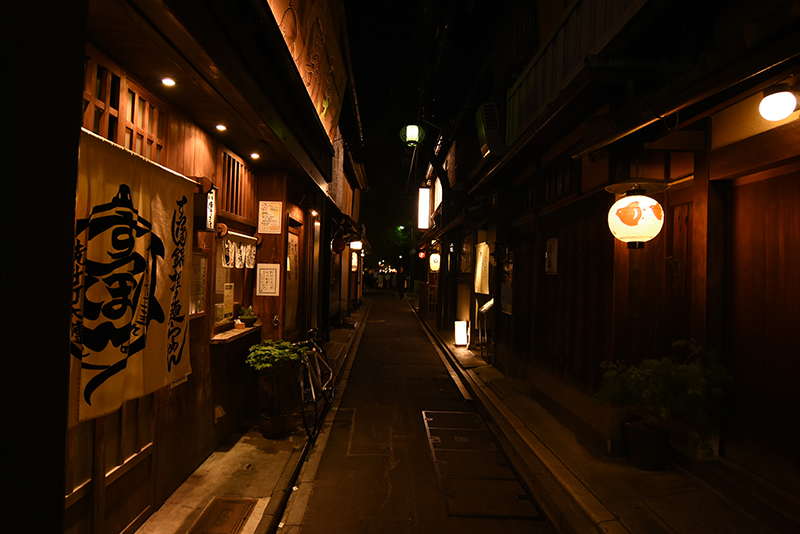 The calm and soothing lighting in Pontochou
The calm and soothing lighting in Pontochou
Group 1 was in charge of Kiyamachi, Ponto-chou, and Kamogawa. Their route was for them to head south along Kamogawa, North through Ponto-chou, and south again through Kiyamachi.
■Kamogawa
The Riverbank of Kamogawa is enveloped in a nice darkness. The existence of Kamogawa itself is a Hero, but it perhaps is even more of a hero because of this darkness. But even a hero like Kamogawa has its faults.
The Riverbeds nice warm lights continue all the way to Minamiza, creating a soothing mood. However, this chain of lights is disturbed by the bright white lanterns on the deck. It absolutely demolishes the atmosphere. With comments like ‘It seems like a Buddhist altar’ and ‘It seems like something from beyond the grave’, we all had wishes for them to fix this crime while we walked out to Shijoudoori.
■Ponto-chou
Night at Ponto-chou is one of the symbolic busiest locations in Kyoto. There are many foreign tourists, and it is one of the locations you can feel confused on where you are while being in Japan.
The hero of Ponto-chou is balance. The lights of the stores are not too bright and punchy, but are subtle. The lights on both sides of alleys balance each other out, instead of trying to one up each other to catch your attention.
Apparently Ponto-chou has a system where if you are renovating your store, you have to ask for advice of your neighbors. We can see some admirable self-restrictions and sacrifices in the name for a better town built into the foundation of Ponto-chou.
■Kiyamachi
At the start of spring, the cherry blossom trees along Takasugawa are lit up and create a glossy colorful scene along the street.
However, when the cherry blossoms are not in bloom, the lights along Takasugawa and Kiyamachi are wrecking the mood of the location, as if it were ‘that one person that doesn’t get the message’. Furthermore, the spotlights that light Takasugawa for people looking at it from the counter seats of the restaurants create a hideous glare that stretches all the way to Kiyamachi. This isn’t an issue of a whether a scene looks great, but even more of a problem. While this is the case, if you continue down Kiyamachi doori, vermilion colored columns appear and you come to see that the scene changes to something wonderful.
If you just take the words ‘Restricted by rules/regulation’, I would react with ‘WHAT A BORING THING TO DO’. However, it seems as if the areas we explored were able to thrive and provide a great lighting environment because of their restrictions. Human-kind has experienced many sudden changes that result in a change in their culture, but perhaps we should do our best to protect and maintain what is passed down. This area really exemplifies that. (Mutsuro Honma)
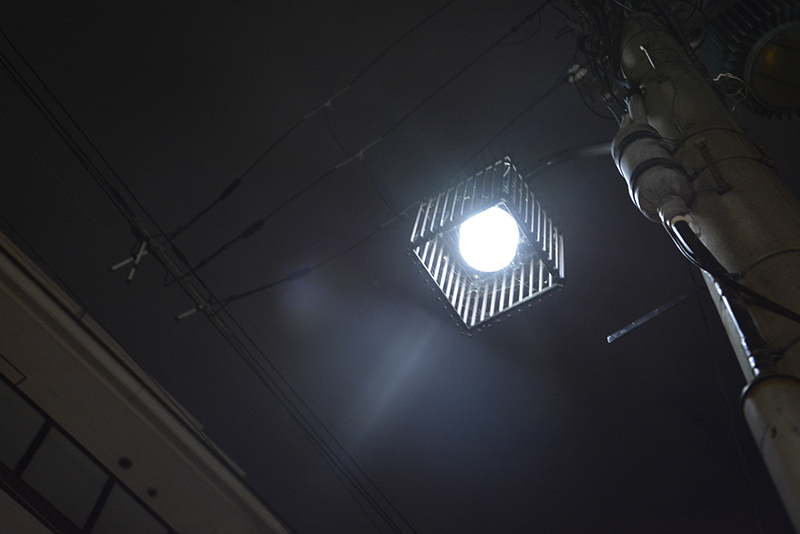 Bright streetlight, unexpected wall spot light
Bright streetlight, unexpected wall spot light
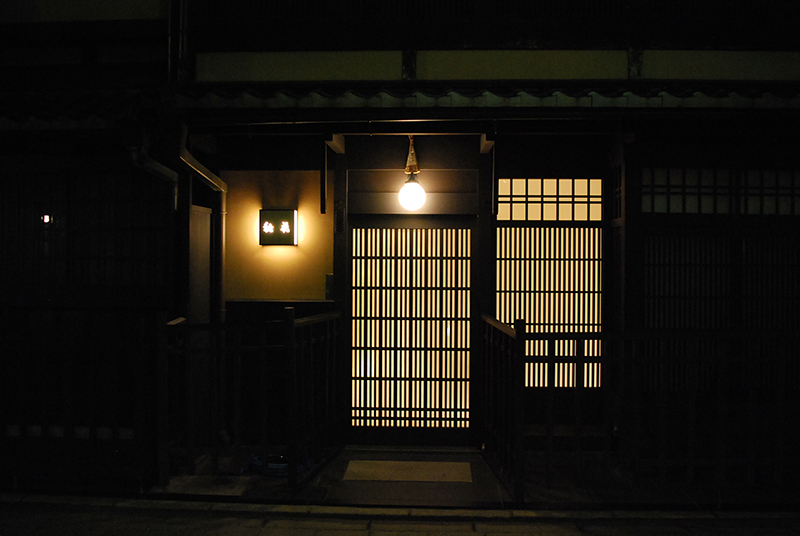 Kobijutsu Street, Light spill from Shoji and Door light
Kobijutsu Street, Light spill from Shoji and Door light
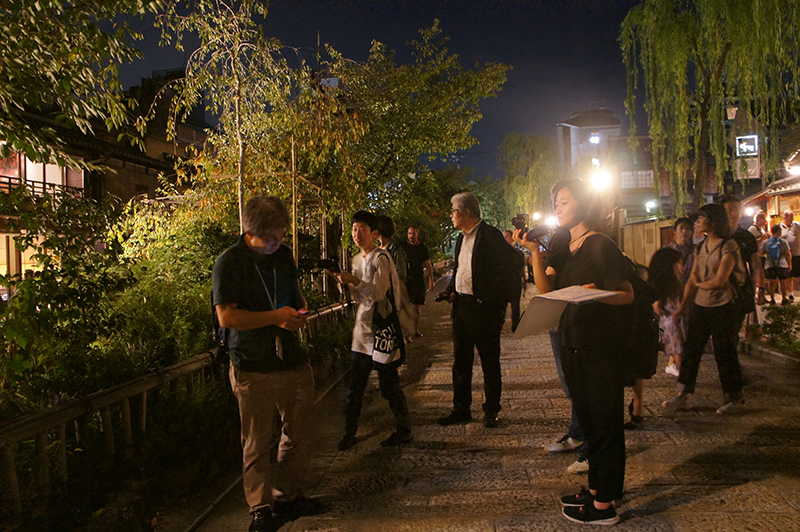 Team exploring while taking photos and taking brightness measurements
Team exploring while taking photos and taking brightness measurements
Group 2: Shirakawa Riverbanks・North Gion Area
We explored the Shirakawa riverbanks’ residential area, Gion Shimbashi where the traditional scene of town is retained, some multi-tenant buildings in the red-light district, and Komon-mae street, where there are one of the best collections of antique artworks even within Kyoto.
■Komon-mae Street
As we walked, our eyes were immediately caught by the sharp white light that is emitted by the streetlights. It became the villain as we quickly identified that it did not fit within the historical and traditional theme of Gion.
The Antiques Street was dark and quiet, but the warm light that spills from the shoji screens and the lights above their doors, give us a glimpse of these buildings with their history and the lives of those people who live within them. It was extremely disappointing that the streetlights ruin the atmosphere with sporadically with their bright white lights.
■Residential Area along Shirakawa River
This area had a soothing atmosphere during daytime, with the greenery and soft sounds of the river that can be experienced along the walkway. However, this completely changes at night, where the streetlights light the area somewhat lonelily. If there were lights that were warmer at a lower height, it would very likely create a more soothing and safe atmosphere.
■Gion Shimbashi
Dedicated as an important architectural cultural heritage, Shimbashi-doori can be seen with traditional townhouses with soft light seeping from the lattice doors that mesh particularly well with the soft spill of lights through the blinds from the second floors. This in combination with the warm lights from the lanterns create a nostalgic space that entices us. The comforting darkness and balance of light resulted us naming the whole passage as the hero.
On the other hand, some shops nearby had spotlights shined on their walls unexpectedly, which everyone seemed disappointed in. But on the other side of the same building, there was the silhouette of an item on display shown through a shoji screen with soft light, recreating the mood of an atmosphere of an old city at night. It was surprising to see a hero and villain of light living together on the same building.
Furthermore, there were shops that lit up the cherry blossom trees along Shirakawa River in an attempt to make the view from their location better. However, these lights result in extremely bright glares, showing a lack of care for their surroundings, which we deemed villain worthy.
■Kanrakugai (Red Light District)
We lastly walked around the red light district in the area, which had shops in traditional townhouses but with color lights and neon signs reminiscent of the Showa-era. You could say that this view with neon lights and a calm, old Japanese town look can only be experienced here in Kyoto or Gion.
This time, we explored many historical passageways, but the excellent and balance lighting treatment that Shimbashi receives in comparison to the other areas around is shocking. We thought it probably is a good idea to now expand their care to the lighting environment to the larger area around it. (Yumi Komatsu)
Group 3 Yasaka Shrine → Kawaramachi
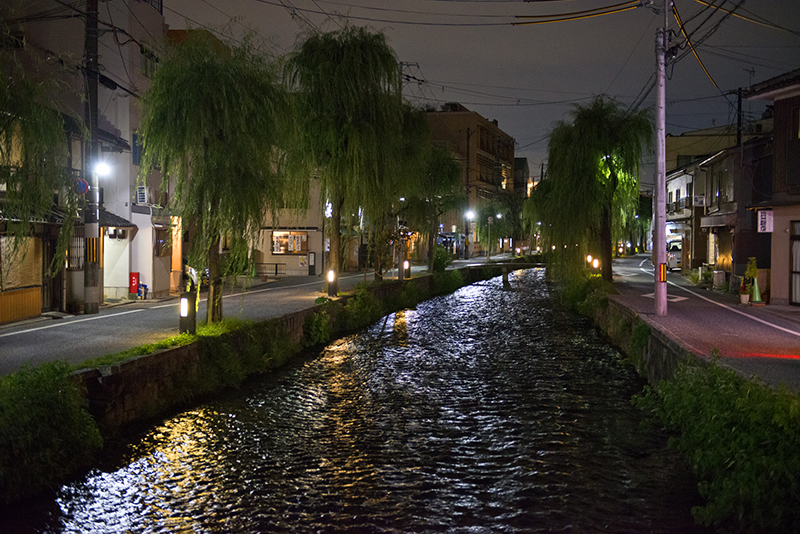 The lantern styled white bollards that run along the river, the villains are the white streetlights
The lantern styled white bollards that run along the river, the villains are the white streetlights
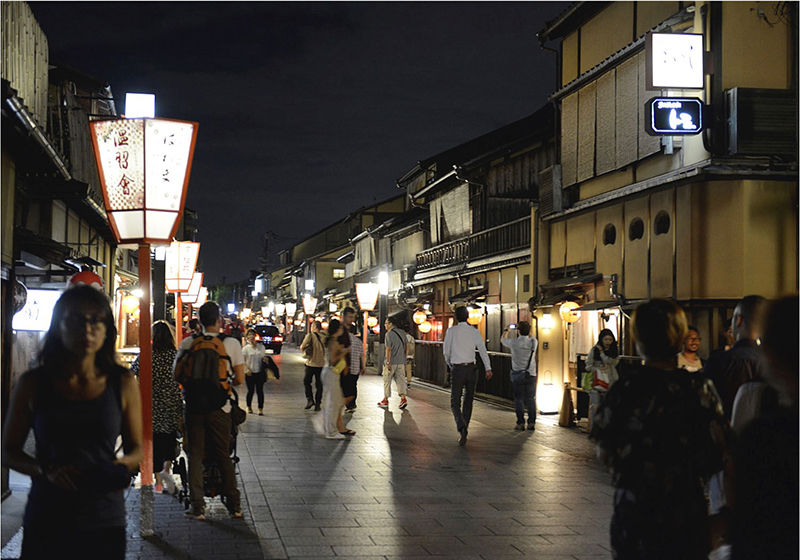 Bonbori lights that leave a slightly mismatched impression
Bonbori lights that leave a slightly mismatched impression
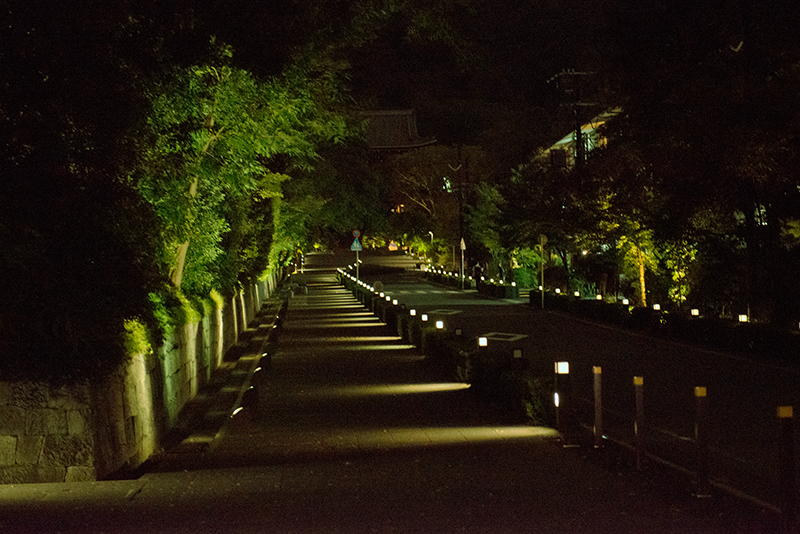 There are no lights that light up the street, but there is a rhythmical contrast between light and shadow
There are no lights that light up the street, but there is a rhythmical contrast between light and shadow
■Okazaki・Gion・Around Chion-in
Group 3 was in charge of the area from Yasaka Shrine to Kawaramachi. First, we explored the riverbanks of Shirakawa River going from Okazaki to Gion. Along the river, there were lighting fixtures that looked like lanterns emitting some light a low color temperature. It created a nice scene in combination with the shallow water and the willows on both sides of the river. However, the white streetlights created a glare that tore through this peaceful scene. It seems the Hero and the Villains are still at war even at the Shirakawa riverbanks.
As we head south through the Higashi-Oodouri Street and head into Chion-in, we were drawn to the darkness that resides in that area. There were low bollard lights on both sides of the driveway and the light that emits from the top of the bollard distinguishes the road from the sidewalk. However, there are close to no lights lighting the road itself. The driveway was enveloped in an even darkness. The sidewalk is lit softly by lights that come from the bottom of the bollard, where it creates a rhythmical patter in conjunction with the lights that light the retaining walls. These convinced us that the scene at this path, is a hero.
■Yasaka Shrine・Hanami Kouji
After taking a photo together outside of Yasaka Shrine, we headed to Hanami Kouji of Gion. This street has traditional architecture on both sides of a stone paved road. When we look at the light sources in Hanami Kouji, there were lights that were integrated into the support beams, Bonbori shaped lights, red lanterns, and store signs etc. However, there were some spots that were too bright, some that were too white resulting in an uneven and mismatched sort of experience as you walked down the street. The Bonbori lights were especially unsettling as they were too large, therefore becoming our villain for this area. There were also some alleys lit basically only by the lights from storefronts creating a soothing scene. That lighting is our Hero for the area. As you head towards Kamogawa, you suddenly see a pharmacy, emitting much more light than anything around it. It is a villain for this lighting environment.
In the back of Hanami Kouji there is the Gion Koubu Kaburenjo, a traditional Japanese theater. To our surprise there were no lighting on the building at all. The same goes for the Yasakakaikan that is next door. There was just the strong light from floodlights. With questions still in our head, we decided to name this a villain. According to later reports, Yasaka Kaikan is becoming an Imperial Hotel after its renovation, and there are also plans for large scale renovations to the Kaburenjo, which currently is closed.
■Kamogawa River
We ended our stroll by walking around Shijouoohashi Bridge. We enjoyed the view of Kamogawa River from the bridge and proceeded to explore the riverbanks. There were many people walking and sitting on the river banks. There were no lights on the river banks, making the space quite dark. But during this season, the river bed shows and light scatters around a little. We named the river bed the hero in this lighting environment. There were also lights that were villain-like. There was a spotlight that was placed on the building that lit past the river and onto the opposite river bank. Kamogawa River is a space and environment shared by those who visit it. This sort of action makes me question their attitude towards others who share the space. (Taiichirou Ishida)
Group 4 Nene no Michi → Ninei Zaka → Kiyomizu Shrine → Ishibekouji
 The light that reflect off of the stone flooring is amazing
The light that reflect off of the stone flooring is amazing
 The light in the arcade
The light in the arcade
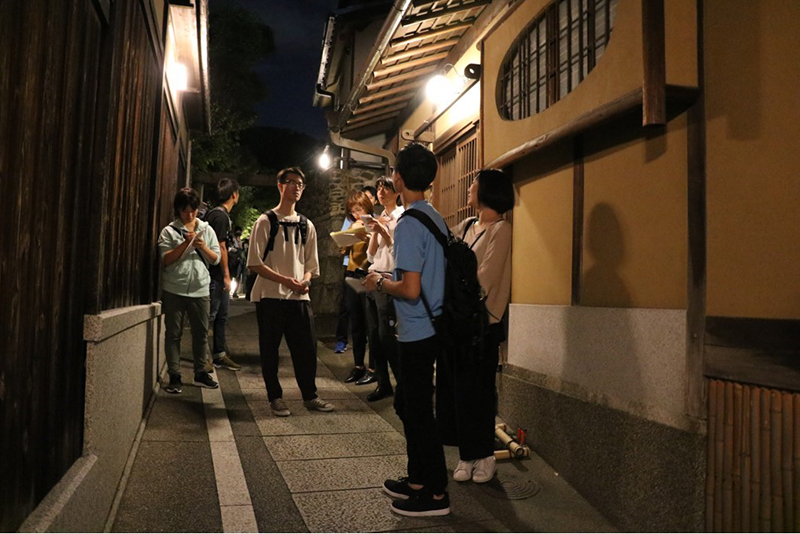 Exchanging opinions even on the side of the streets
Exchanging opinions even on the side of the streets
Group 4 strolled from Nene no Michi to Ninei Zaka, then to Kiyomizu Shrine, and from Ishibekouji to Kawaharachou.
■Nene no michi Surroundings
Before we explored Nene no michi, we slipped through a shopping arcade. The stores featured styled lanterns that we naturally stopped to look at. The lanterns played the role of advertisements you would normally see in other arcades, as billboards and store signs but as light sources as well. But when I looked up, there was a large incandescent lamp. We wondered whether this was a later addition or something that was there from before. Is it okay at this brightness? Should they even have this light in the first place? Causing some lively discussion.
At Nene no Michi, we kept looking behind our shoulders, saying ‘It’s dark but it still somehow establishes itself as street lighting’ multiple times. We reached a conclusion that perhaps this is because of Kyoto’s atmosphere that this is acceptable. You wouldn’t notice that there were only street lights on one side of the street without paying close attention. It was a fun exploration, where I noticed things I wouldn’t normally notice.
■Ninei Zaka
At Ninei Zaka, we talked about the relationship between roads and stores. Specifically our thoughts on how the stores lights mesh well with the town’s atmosphere without standing out. Some stores lit were lit with white lights, which is a great example of a store standing out, but wrecking the preexisting atmosphere of the town.
■Ishibekouji
At Ishibekouji, the way the wall fixtures were attached was fantastic. They were placed at a perfect angle in relation to the angle of the hill. As we say ‘It’s beautiful’ while heading down the street, an apartment’s lighting ripped the excitement from us. The orthodox placement of lights sort of just destroyed the scene that we were just enjoying.
Each town has their very own culture, tradition, and history that has been accumulating. We felt the emphasis on lighting the towns without destroying that traditional atmosphere on this exploration. But that also means you are able to do thing you cannot in other locations, like in Nene no Michi. It was a stroll where we could reaffirm the historical importance of Kyoto in our minds. (Amane Kotani)
Our Kyoto expedition was one that was filled with calming darkness. There were many places we thought were disappointing, but we were also able to feel the pride of Kyoto’s citizens in some locations, leading us to be excited for the future development of this city. (Noriko Higashi)





